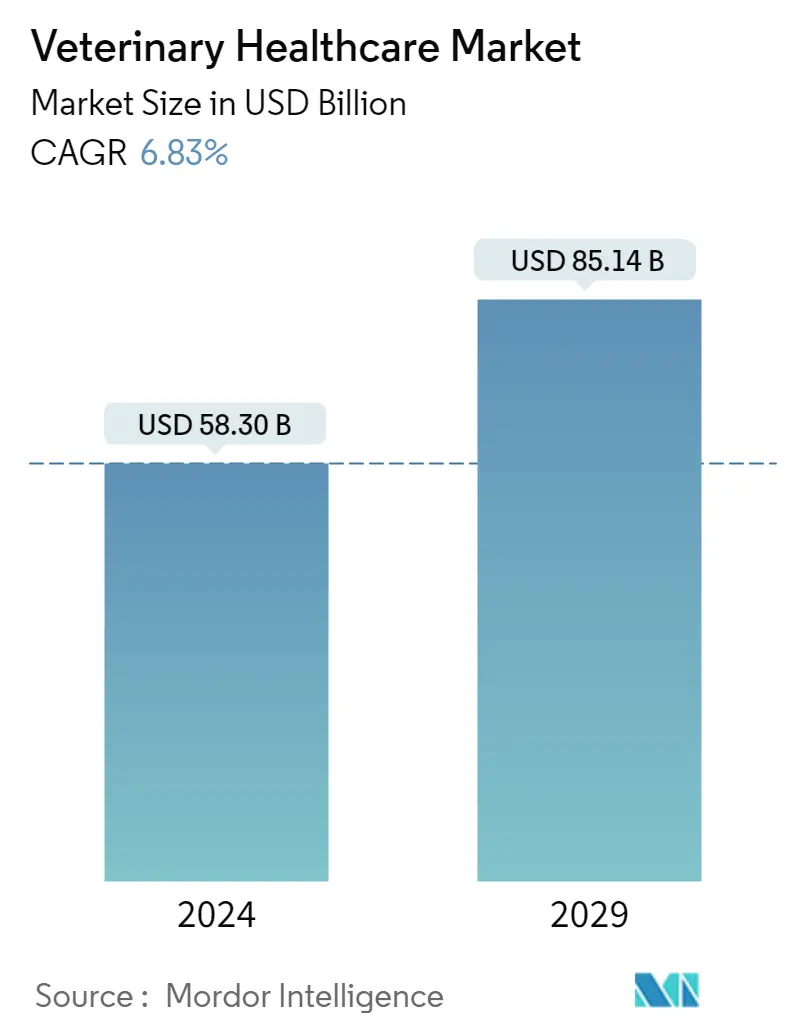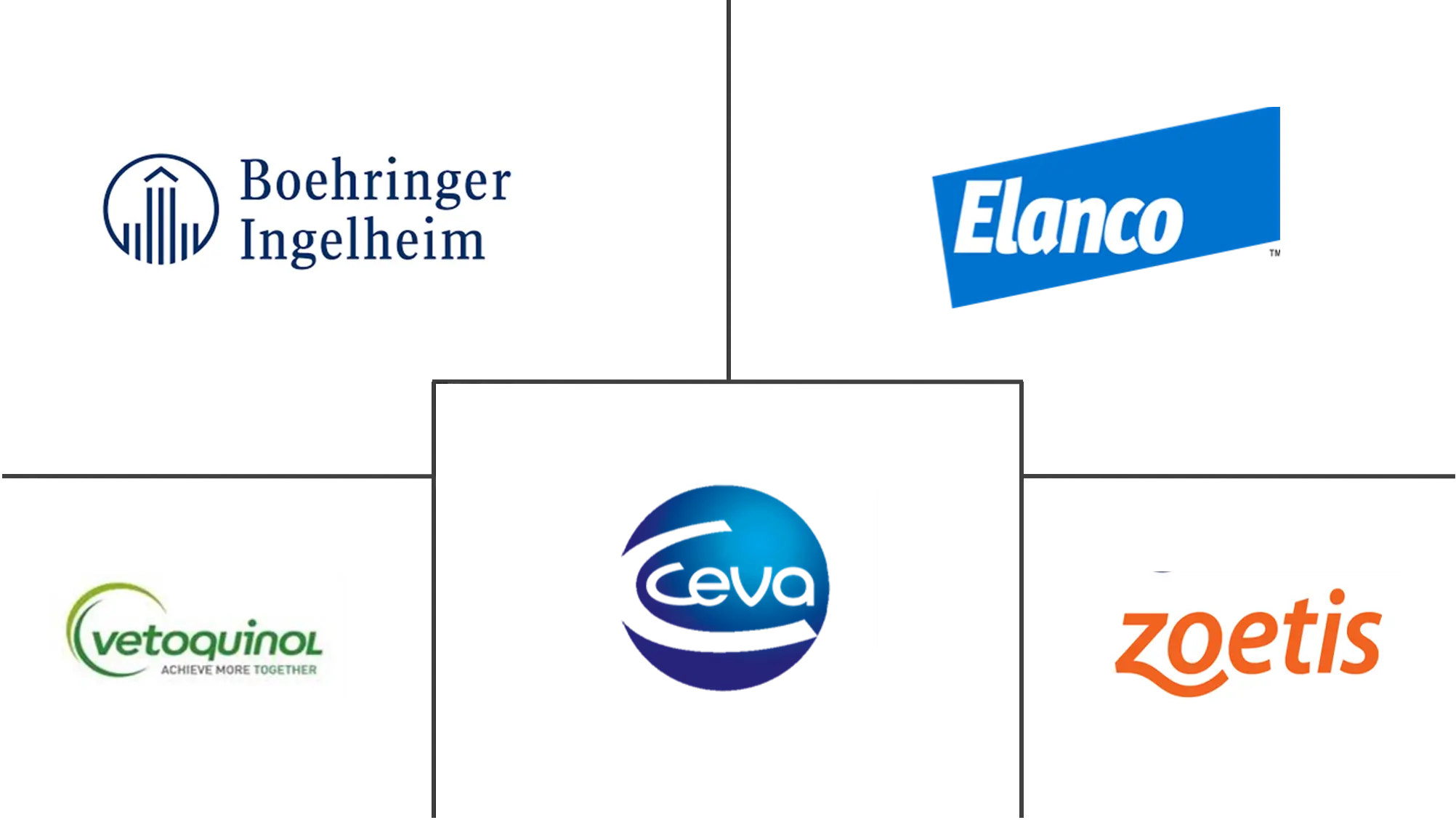Market Size of Veterinary Healthcare Industry

| Study Period | 2021 - 2029 |
| Market Size (2024) | USD 58.30 Billion |
| Market Size (2029) | USD 85.14 Billion |
| CAGR (2024 - 2029) | 6.83 % |
| Fastest Growing Market | Asia-Pacific |
| Largest Market | North America |
Major Players
*Disclaimer: Major Players sorted in no particular order |
Veterinary Healthcare Market Analysis
The Veterinary Healthcare Market size is estimated at USD 58.30 billion in 2024, and is expected to reach USD 85.14 billion by 2029, growing at a CAGR of 6.83% during the forecast period (2024-2029).
Supply disruptions and shortages of veterinary medicines were observed in several countries, primarily due to the temporary lockdowns of manufacturing sites, export bans, and increased demand for therapy for the treatment of COVID-19. Governments are taking measures to mitigate the supply of medicines. For instance, in 2020, the European Medicines Agency issued guidance for companies responsible for veterinary medicines concerning adaptations to the regulatory framework, primarily to address the challenges faced during this pandemic. Also, the Centers for Disease Control and Prevention, in July 2020, recommended specific guidelines to veterinary professionals for treating companion animals during the COVID-19 pandemic. Hence, it is observed that the pandemic had a significant impact on the market studied. However, the market has reached pre-pandemic in terms of demand for veterinary health products and services. The market is expected to witness significant growth in a short period.
The market is primarily driven by the approval of new products related to treating animal disorders. For instance, in June 2022, DechraVeterinary Products announced that it is VETRADENT Liquid Water Additive for dogs and cats and received the seal of acceptance to help control tartar from the Veterinary Oral Health Council (VOHC). The seal has been granted for dogs after adequately demonstrating safety and efficacy. Also, in October 2021, BASF Animal Nutrition, a supplier of innovative feed additives for livestock, aquaculture, and companion animals, and trinamiXGmbH, a wholly owned subsidiary of BASF SE, joined forces to introduce trinamiX' Mobile Near Infrared (NIR) Spectroscopy Solution to the feed industry. With this launch, the portable NIR solution provides customers across the entire value chain with a fast and reliable on-site analysis of animal feed and ingredients. With the launch of such veterinary products, the market studied is expected to witness healthy growth in the coming years.
Many companies focus on frequent product launches that may drive worldwide growth. For instance, in June 2022, R-BiopharmAG acquired AusDiagnostics. With the acquisition, R-Biopharmexpanded its product portfolio with molecular biology multiplex diagnostics, extraction reagents, and laboratory automation equipment for animals and humans. In addition, in January 2022, IDEXX Laboratories, Inc. expanded its reference laboratory menu of tests and services that will enable veterinarians to meet better the challenges of diagnosing and treating cancer. The expansion includes a liquid biopsy test that utilizes next-generation DNA sequencing technology to diagnose canine cancers. Hence, the market for veterinary healthcare is expected to witness substantial growth over the forecast period due to the aforementioned factors.
However, the high cost of diagnostic imaging equipment and veterinary medicines and the high price of veterinary services is anticipated to restrain the market's growth over the forecast period.
Veterinary Healthcare Industry Segmentation
Veterinary healthcare can be defined as the science associated with diagnosing, treating, and preventing animal diseases. The increasing importance of the production of livestock animals is generating growth in the veterinary healthcare market. The Veterinary Healthcare Market is Segmented by Product (Therapeutics and Diagnostics), Animal Type (Dogs and Cats, Horses, Ruminants, Swine, Poultry, and Other Animal Types), and Geography (North America, Europe, Asia-Pacific, Middle-East and Africa, and South America). The market report also covers the estimated sizes and trends for 17 countries across major regions globally. The report offers the value (in USD million) for the above segments.
| By Product | |||||||
| |||||||
|
| By Animal Type | |
| Dogs and Cats | |
| Horses | |
| Ruminants | |
| Swine | |
| Poultry | |
| Other Animal Types |
| By Geography | ||||||||
| ||||||||
| ||||||||
| ||||||||
| ||||||||
|
Veterinary Healthcare Market Size Summary
The veterinary healthcare market is poised for significant growth, driven by the introduction of new products and innovations aimed at treating animal disorders. The market has rebounded to pre-pandemic levels, with increasing demand for veterinary health products and services. This resurgence is attributed to the approval of advanced veterinary products, such as DechraVeterinary Products' VETRADENT Liquid Water Additive and BASF's Mobile Near Infrared Spectroscopy Solution. These developments, alongside strategic acquisitions and expansions by key players like R-BiopharmAG and IDEXX Laboratories, are expected to propel the market forward. However, challenges such as the high cost of diagnostic imaging equipment and veterinary medicines may pose constraints to market growth.
North America remains a dominant region in the veterinary healthcare market, supported by high pet adoption rates and proactive initiatives by organizations like Best Friends Animal Society and the California Animal Welfare Funders Collaborative. These efforts, coupled with increased consumer spending on pet healthcare, are driving market expansion. The introduction of new vaccines and treatments, such as Merck Animal Health's initiatives and Zoetis' FDA-approved products, further underscores the market's growth trajectory. Major companies are actively engaging in regional expansions, mergers, and collaborative research to enhance their competitive edge, ensuring a robust market landscape over the forecast period.
Veterinary Healthcare Market Size - Table of Contents
-
1. MARKET DYNAMICS
-
1.1 Market Overview
-
1.2 Market Drivers
-
1.2.1 Advanced Technologies Leading to Innovations in Animal Healthcare
-
1.2.2 Increasing Initiatives by Governments and Animal Welfare Associations Globally
-
1.2.3 Increasing Productivity at the Risk of Emerging Zoonosis
-
-
1.3 Market Restraints
-
1.3.1 Use of Counterfeit Medicines
-
1.3.2 Increasing Cost of Animal Testing and Veterinary Services
-
-
1.4 Porter's Five Forces Analysis
-
1.4.1 Threat of New Entrants
-
1.4.2 Bargaining Power of Buyers/Consumers
-
1.4.3 Bargaining Power of Suppliers
-
1.4.4 Threat of Substitute Products
-
1.4.5 Intensity of Competitive Rivalry
-
-
-
2. MARKET SEGMENTATION (Market Size by Value - USD million)
-
2.1 By Product
-
2.1.1 Therapeutics
-
2.1.1.1 Vaccines
-
2.1.1.2 Parasiticides
-
2.1.1.3 Anti-infectives
-
2.1.1.4 Medical Feed Additives
-
2.1.1.5 Other Therapeutics
-
-
2.1.2 Diagnostics
-
2.1.2.1 Immunodiagnostic Tests
-
2.1.2.2 Molecular Diagnostics
-
2.1.2.3 Diagnostic Imaging
-
2.1.2.4 Clinical Chemistry
-
2.1.2.5 Other Diagnostics
-
-
-
2.2 By Animal Type
-
2.2.1 Dogs and Cats
-
2.2.2 Horses
-
2.2.3 Ruminants
-
2.2.4 Swine
-
2.2.5 Poultry
-
2.2.6 Other Animal Types
-
-
2.3 By Geography
-
2.3.1 North America
-
2.3.1.1 United States
-
2.3.1.2 Canada
-
2.3.1.3 Mexico
-
-
2.3.2 Europe
-
2.3.2.1 France
-
2.3.2.2 Germany
-
2.3.2.3 United Kingdom
-
2.3.2.4 Italy
-
2.3.2.5 Spain
-
2.3.2.6 Rest of Europe
-
-
2.3.3 Asia-Pacific
-
2.3.3.1 China
-
2.3.3.2 Japan
-
2.3.3.3 India
-
2.3.3.4 Australia
-
2.3.3.5 South Korea
-
2.3.3.6 Rest of Asia-Pacific
-
-
2.3.4 Middle-East and Africa
-
2.3.4.1 GCC
-
2.3.4.2 South Africa
-
2.3.4.3 Rest of Middle-East & Africa
-
-
2.3.5 South America
-
2.3.5.1 Brazil
-
2.3.5.2 Argentina
-
2.3.5.3 Rest of South America
-
-
-
Veterinary Healthcare Market Size FAQs
How big is the Veterinary Healthcare Market?
The Veterinary Healthcare Market size is expected to reach USD 58.30 billion in 2024 and grow at a CAGR of 6.83% to reach USD 85.14 billion by 2029.
What is the current Veterinary Healthcare Market size?
In 2024, the Veterinary Healthcare Market size is expected to reach USD 58.30 billion.

